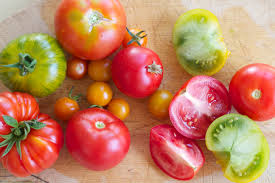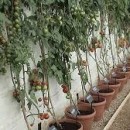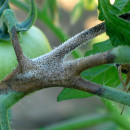It really is possible to grow tomatoes in our cool northwest maritime climate, and Dick Schneider of RainCoast Farms wants to share a few ideas on how. Since 2006, Dick has grown over 400 varieties of tomatoes at his non-profit research farm right here in Port Townsend, generously donating hundreds of pounds of sweet, glistening fruit to our local food bank at the end of each season. The ability to share an abundance of juicy tomatoes with neighbors is a gardener’s dream. Follow Dick’s simple plan, and you, too, can be a tomato success story:
- Variety: First and foremost, choose the right variety. Many commercial selections just don’t succeed in our region. Thankfully, Dick has compiled a list of varieties that grow best on his farm – and in your garden (see list at end of article). Many of these varieties are available as starts at the Jefferson County Farmer’s Market.
- Soil: Choose light, compost rich, slightly acidic soil that is non-compacting.
- Water: Less is more when it comes to keeping tomato plants happy. Be consistent, avoiding conditions that are either too dry or too wet. It is alright if the surface dries out, but the soil should always feel somewhat moist beneath. When your plants are young, nurture them along by using room temperature water. And never allow your plant to wilt from lack of moisture.
- Fertilizer: Tomatoes like a little fertilizer every week. 5:1:1 (fish emulsion) is the perfect blend early in the season, but, come mid-season, your plant needs more in order to form fruit. At this point, a blend of 5:15:20 blend works best.
- Location: Tomatoes need optimum sun, so the best location is one where the plants receive the most sun. Planting near a south-facing wall can also help.
- Temperature: Tomatoes prefer a minimum soil temperature of 55 degrees F. and a maximum soil temperature of 85 degrees F. to grow their best. But our soil struggles to get above 50 degrees during the early part of the season. Growing tomatoes in raised beds, a greenhouse, or 20 gallon containers are a few methods that can maximize soil temperatures. Air temperatures should run between 65 and 85 degrees F. during the daytime and 55 – 65 degrees F. at night. Temperatures above 85 degrees will inhibit pollination, resulting in all blossoms and no fruit. It rarely gets that hot here, but, if you are growing your tomatoes in a greenhouse, monitor the temperature closely.
- Light: Flavor is dependent on sunlight and tomatoes need LOTS of sunlight. You can optimize your light by planting in a spot that receives, at minimum, full afternoon sun from noon to 5:00 p.m.
- Plant Management: Most home-grown tomatoes are indeterminate varieties. They climb high, are heavy, and need to be supported. Provide a cage or a string for the plant to climb along. Tomato clips work great to hold it in place. To prune, remove the side shoots and inner branches. This allows the plant to focus energy on creating large, sweet tomatoes rather than maintaining excess greenery, and helps maintain good air circulation.
- Common Problems: Tomato hornworm is rarely seen in our region but aphids might populate your plants. Ladybugs are a great way to keep aphids in check. Another common problem is blossom end rot, which is seen more frequently in Roma tomatoes than in slicers or cherries. This is caused by a deficiency of magnesium and calcium in soil, a common issue in our maritime northwest. Epsom salt is high in magnesium and is a sure fix. Periodically, apply a teaspoon to the base of each plant and make sure your soil is well fortified with bone meal, cottonseed meal, or gypsum. Or, make a foliar spray from one tablespoon Epsom salt to one gallon of water, spraying at transplant, first flowering, and fruit set. Last, but certainly not least, is the dreaded late blight, which is discussed in the next paragraph.
- End of Season Management: September 5th to 15th is the perfect window for utilizing end of season management techniques. Don’t be fooled by good weather. Fall is coming and your tomatoes may put out more blossoms, but additional fruit is unlikely. Cut off all blossoms at this time as well as the growing tip of each plant. Remove most of the leaves, too. Not only does this maximize sun exposure to the fruit, it allows the plant to focus on ripening. It also increases air circulation which in turn helps curb the effects of late blight. Late blight is a windborn watermold that thrives in damp, wet soil, and sweeps freely through our region in fall. It is endemic here, so, don’t blame yourself if it shows up in your garden. If you are lucky enough to own a greenhouse, your tomatoes may not succumb to this common problem. But, if your plants do become infected, you will need to harvest immediately and ripen your tomatoes off the vine. Johnny’s Seed Company has this wonderful video on late blight: https://www.youtube.com/watch?v=6PvquaRSV7E. WSU provides this information on late blight: http://mtvernon.wsu.edu/path_team/tomato.htm
Dick’s Recommended Tomato Plants:
Out of 400 tested varieties, these have given Dick consistent encore performances:
Roma type (best in greenhouse): Golden Rave
Slicers for outdoors: Celebrity, Glacier, Siberian, Siletz, Stupice, Willamette
Slicers for greenhouse: Bella Rosa, Bush Goliath, Charger, Clermon, Creole, Country Taste, Jaune Flamme, Goliath, Moskvich, Mr Stripey, SunRay, Taxi
Heirloom (all grow best grown in greenhouse): Abe Lincoln, Amana Orange, Aunt Ruby’s German Green, Ananas Noire, Big Beef, Brandywine, Black Brandywine, Cherokee Purple, ,Cody’s Rainbow, Coeur de Boeuf, Geronimo, Lemon Boy, Mortgage Lifter, Texas Star, SunRay
Cherry: Gold Nugget, Golden Grape, Pink Bumble Bee, Red Alert, Sakura, Snowball, Sun Cherry, Super Sweet 100, Sun Gold, Sweat Hearts, Sweet Treats, Sweet Million, Toronjino, Tumbler, White Cherry






